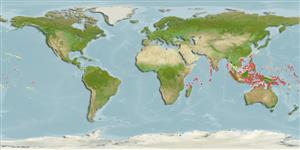Common names from other countries
Environment: milieu / climate zone / depth range / distribution range
Ecología
marino; salobre asociado a arrecife; rango de profundidad 0 - 20 m (Ref. 41464). Tropical; 30°N - 15°S
Indo-West Pacific: East Africa to Samoa, north to the Ryukyus, south to the southern Great Barrier Reef.
Tamaño / Peso / Age
Maturity: Lm ? range ? - ? cm
Max length : 47.0 cm TL macho / no sexado; (Ref. 57749)
Short description
Claves de identificación | Morfología | Morfometría
Vértebra: 105 - 113. Body depth 36-51 times the total length (TL) . Head length 10-15 times TL. Dorsal and anal fins continuous with caudal, clearly behind the anus. Distances from snout to dorsal origin, from snout to anal origin and from snout to anus are 75%, 69% and 67% of TL, respectively. Small pectoral fins. 63 pores along the lateral line from head to anus. Adults all brown on the back and lighter on the belly; juveniles have an orange-yellow back and a bluish belly. Specimens in the rivers can reach 47 cm TL (Ref. 57749).
Occurs in estuaries and lower parts of the rivers at juvenile and immature adult stages in slow-running waters on sandy bottoms. Mature females stay on shallow marine bottoms; males are pelagic. Reproduction occurs offshore. Leptocephali migrate to the littoral to follow up with their growth. Feeds on fish and invertebrates, especially crustaceans (Ref. 57749). Minimum depth reported taken from Ref. 86942.
Life cycle and mating behavior
Maturities | Reproducción | Spawnings | Egg(s) | Fecundities | Larva
Castle, P.H.J., 1986. Moringuidae. p. 187-188. In M.M. Smith and P.C. Heemstra (eds.) Smiths' sea fishes. Springer-Verlag, Berlin. (Ref. 5501)
IUCN Red List Status (Ref. 130435)
CITES (Ref. 128078)
Not Evaluated
Threat to humans
Harmless
Human uses
Herramientas
Special reports
Download XML
Fuentes de Internet
Estimates based on models
Preferred temperature (Ref.
115969): 27.1 - 29.3, mean 28.7 (based on 1829 cells).
Phylogenetic diversity index (Ref.
82804): PD
50 = 0.5003 [Uniqueness, from 0.5 = low to 2.0 = high].
Bayesian length-weight: a=0.00102 (0.00046 - 0.00225), b=3.06 (2.88 - 3.24), in cm Total Length, based on all LWR estimates for this body shape (Ref.
93245).
Nivel trófico (Ref.
69278): 3.1 ±0.1 se; based on diet studies.
Fishing Vulnerability (Ref.
59153): Moderate vulnerability (37 of 100).
